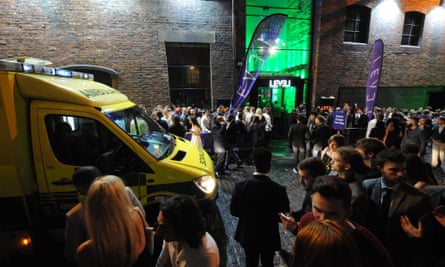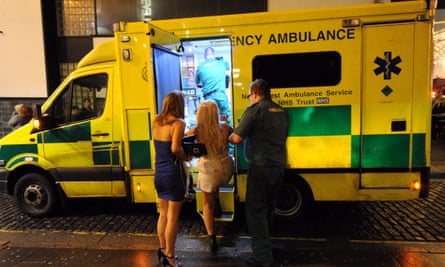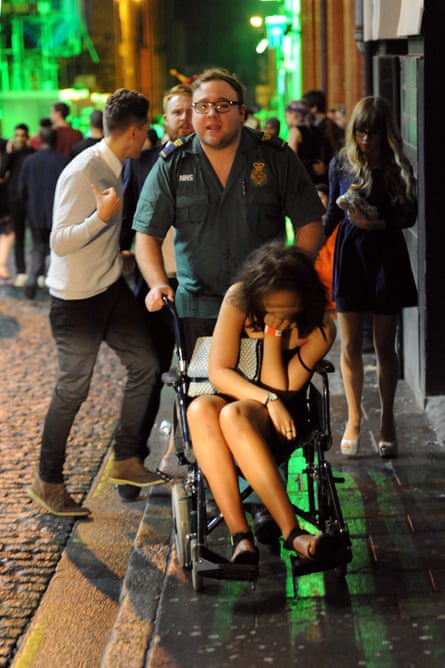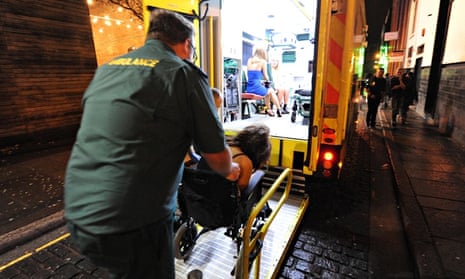It’s 7pm on New Year’s Eve and the streets of Liverpool are bubbling with the anticipation of seeing out 2014 with a bang. For most people, the evening’s consequences will be no more severe than a hangover and the material for a few funny stories. But for the staff arriving at the accident and emergency department at the Royal Liverpool, the city’s main hospital, New Year’s Day wasn’t such a cheerful prospect. The hospital, based in the heart of the city, is usually the first to deal with the overindulgence of the city centre’s revellers, and paramedics waiting for callouts in the ambulance bays are apprehensive about the night ahead.
When I return at 1am on New Year’s Day, every bed is full and the bays are empty. A girl in a long black dress hitched above her knees limps through the main entrance, helped by two friends. Minutes later a young man stumbles through the gates and blearily asks where the entrance to A&E is. Blood is streaming from his nose and he is holding his left arm close to his chest. He stops to throw up before crossing the car park to the entrance and a member of staff guides him through the doors. Half an hour later an ambulance pulls into the bay and as the back doors open, the slurred and expletive-filled demands of a man on a stretcher can be heard.
Alcohol-related admissions put A&E departments under severe pressure. Recent estimates have suggested that up to three in every 10 patients attending A&E in the UK are there because of alcohol – more at weekends. Now some people are suggesting that more radical action needs to be taken. Last Saturday, Dr Cliff Mann, president of the College of Emergency Medicine, told the Observer that the unsustainable pressure on A&E could be reduced only by arresting more drunk people as a deterrent. “If more people knew that if they got drunk they were going to be arrested, they wouldn’t drink in the first place,” he said.
At the Royal Liverpool, a paramedic waiting in the early hours for his next call attests to the scale of the problem. “A lot of people coming in now have been found drunk in the centre,” he says. “They’ve had accidents, got into fights or, most likely, drunk so much they just can’t control themselves. Often they don’t need A&E help – they just need to sleep it off. But then they’re drunk so they don’t know what they need and just call us.”
That kind of misuse of the emergency services has become a huge issue. “A lot of people treat the ambulance like a free cab service,” says Ged Blezard, director of emergency services for the North West Ambulance Service, citing a man in Manchester who rang to ask if he could book an ambulance for 11.45 in case he needed one due to drinking too much.
“We definitely have our ‘regulars’,” says the paramedic outside the Royal Liverpool, who asks to remain anonymous. “You can often guess from the area who it’s going to be and we’re on first-name terms with them. They get absolutely hammered every weekend and that’s normal for them.”
Increasingly, taxi drivers say they too are being asked to take party-goers to A&E because of the waiting times for ambulances. Dave Henley, a black-cab driver in Liverpool, is working on what will be his fifth New Year’s Eve. “I’ve become a bleeding ambulance service over the past few years for drunk people who’ve just lost the plot,” he says as we drive down Dock Road towards the hospital early in the evening. “I’ve literally had to scrape people up off the pavement and carry them to the hossy doors.” He recalls one incident when he was hailed by a girl sitting outside a pub. “She was absolutely hammered and started throwing up. She was too drunk to tell me her address and seemed in a really bad way, so I took her to A&E as she would have had nowhere else to go.
“It’s always the same. Early on they all come in me cab looking a million dollars with bottles of bubbly in their hands, and then after midnight they’re falling over themselves, getting into fights,” he says.
Several initiatives have sprung up over the past few years to provide temporary shelter for the intoxicated who are only in need of minor attention, allowing A&E to concentrate on more pressing cases. In Cardiff city centre, a chapel has been given over to a team of nurses and street pastors on Friday and Saturday nights over the past year to care for those found drunk on the streets. In the seaside town of Southport in Merseyside, an alcohol recovery centre, known as the “drunk tank”, led by NHS Southport and Formby clinical commissioning group, has been set up to run over the festive season. It can take up to 10 patients and is equipped with showers, beds and health professionals.

Dr Alan Owens, A&E consultant and alcohol lead at Southport and Ormskirk Hospital NHS Trust, who helped to launch the centre, says: “It’s hard to say how much this has helped at this stage. But the centre has been regularly taking drunk and disorderly people off the streets, and if that means a few less drunk people in A&E, that’s a good thing. In my experience, drunken people in A&E can be among the most time-consuming patients.”
The verbal and physical abuse many A&E staff face from drunken patients was one of the triggers for Mann’s proposal. By the time most people are waking up on New Year’s Day, five paramedic teams from the North West Ambulance Service have been assaulted by drunk patients. “This takes paramedics off the streets as they need to recover and speak to the police, which then affects how we respond to more needy patients later on,” Blezard tells me. Not long ago, one paramedic was off work for several months with a fractured skull following an attack by abusive drunk patient.
One young man, who asked not to be named, had to be rushed to a London A&E last weekend with a broken wrist after falling down the stairs at his friend’s house. The following day, he was shocked to discover that he had called a nurse trying to bandage his arm “a bitch” and refused to cooperate with doctors trying to x-ray his arm.
“It’s embarrassing and I feel really ashamed,” he said. “I have no idea how I got like that. I’ve never really been violent when drunk before so I don’t why I lashed out that night. It’s scary.” He felt so bad about his behaviour that he called the hospital and asked if he could apologise to the nurse.
The level of abuse from some patients requires police intervention. During the past few festive seasons, the A&E department at Manchester Royal Infirmary has had a police officer on site to deal with difficult behaviour, because of the large number of times staff were having to call the police due to drunk patients being abusive or violent.
Jonathan Smith, matron for emergency services in central Manchester, said the officer had provided a huge source of support. “More than anything, I think it was simply the presence of a police uniform that helped. It’s sad that you need a police officer to prevent people treating staff badly, but this was the case, and any difficult behaviour was dealt with much more effectively.”
Lack of funding means the service is no longer operating, and Smith is anxious about how the department will cope with difficult patients. “Although we have gone through training to deal with challenging behaviours, there are some situations we just can’t deal with.” Smith recalls incidents in which patients have thrown furniture at staff and threatened to hurt other patients or colleagues. “These are the times when we need police help. Often the police don’t respond fast enough to deal with the issues, so they easily escalate.”
While services decide how to cope with increasing numbers of drunk A&E admissions, many health professionals are urging individuals to take responsibility. “The people Mann is talking about are those who go out in the evening, become appallingly drunk and need A&E attention because they fell over, choked on their own vomit or fell asleep and got hyperthermia,” says Dr Katherine Henderson, an A&E consultant at St Thomas’ Hospital London and a registrar at the College of Emergency Medicine, who works closely with Mann. Although she supports his proposal that more drunk people should be arrested, she believes the key is for people to take responsibility before the emergency services become involved.

“It often feels that people are not prepared to make any plans at the end of the evening to get safely home, look after their friends and take control. The existence of the A&E as a safety net means people are not so careful. We would plead with patients to ask themselves: How can you control yourself? How can you get home? If you know you become aggressive and get into fights when you drink too much, then don’t do it. It shouldn’t be an excuse for bad behaviour. A whole department can be deeply disrupted from just one drunk patient.
“The aim is to stop people getting to that stage, and that is the responsibility of the individual and their friends. We’ve had patient monitors smashed and staff threatened. If you get to a stage where you hit a nurse in a hospital, you should not drink like that again.”
But for doctors, the more serious issues around drinking are not focused on New Year’s Eve – or even the disorder often seen in city centres on Saturday nights. Ninety per cent of hospital admissions related to alcohol are not weekend binge-drinkers but individuals with long-term problems caused by chronic consumption, such as cirrhosis of the liver.
Professor Sir Ian Gilmore is a leading expert on liver disease and a former president of the Royal College of Physicians. He says liver disease is one of the biggest health issues the NHS is facing and cause of an increasing proportion of deaths. “Most of that harm is being done behind closed doors at home,” he says, “not on the streets on Saturday nights.”
Hours before the flood of drunk patients filled the Royal Liverpool’s A&E, I meet a 53-year-old man sitting in the still-quiet ward after being treated for alcohol withdrawal symptoms. John called an ambulance when his body began to shake so badly that he was unable to move. He lives alone and has been off alcohol for two weeks, although has suffered from alcohol dependence for almost 30 years and has had five visits to A&E in the past year – the most recent being for a pulmonary embolism. John is an example of the many patients for whom alcohol is part of a much more deeply rooted problem.

Gilmore says: “One of the challenges in A&E is to distinguish between someone who is simply drunk and someone who has been drinking but also has a serious medical problem. There is a tendency to blame every drinker for their predicament, but there are 1.5 million people in this country dependent on, or addicted to, alcohol – which is an illness. Alcohol may be legal, but it is a drug of dependence, and how we use it is a huge issue affecting society.”
According to Gilmore, alcohol is the single biggest factor in young men dying between the ages of 16 and 24, whether it be through accidents, suicide or violence. “We’ve got this macho drinking culture in this country where consuming huge amounts is often considered in some way heroic. We do need a culture change but nobody has a magic bullet. The easiest and quickest way to bring about a cultural shift is to get rid of cheap supermarket drink at pocket-money prices and stop drink being available and heavily marketed 24/7,” he says.
Peter Howarth is the manager of Dr Duncan’s, a public house in Liverpool named, ironically, after William Henry Duncan, the UK’s first medical officer of health, who was appointed to the role on New Year’s Day 1847. “From my experience, alcohol is generally something people enjoy and use to relax and have fun. There are the odd customers who get aggressive, but as a manager you try and monitor people and intervene before they get to the stage of being disorderly. As a city centre pub, we have a nice mix of a hardcore regular crowd and also people merely passing through the city. Most of them seem to just have fun.”
When taxi driver Dave Henley picks me from A&E at 2.30am we drive back through the Waterloo area down South Road, a popular local runway of bars bordering the mouth of the Mersey. It is hard to draw any firm conclusions from the scene that we find: one man grapples a paramedic trying to remove him from the aftermath of a fight while a group of girls with their heels in their hands are huddling around a friend being sick. But against the backdrop of blue flashing lights and loud music, others are dancing and laughing.
When I get out at the end, as the road meets the water, a group of revellers are linking arms and happily singing Auld Lang Syne when their chants are cut short by the sight of a man shivering. Unable to ascertain where the man’s friends are, someone starts to call 999, but then decides it would be quicker to take back him back down South Road, where more ambulances are arriving.

Comments (…)
Sign in or create your Guardian account to join the discussion